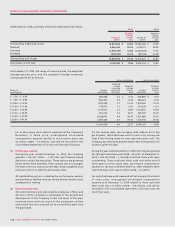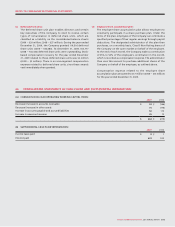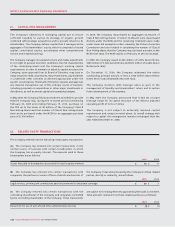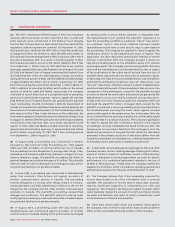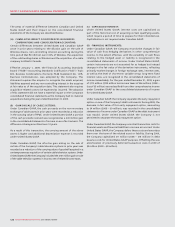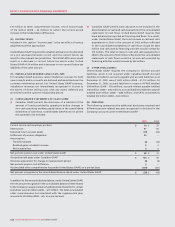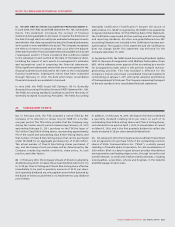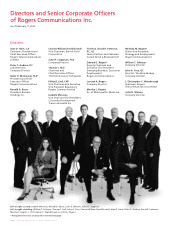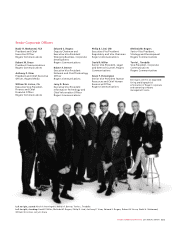Rogers 2009 Annual Report Download - page 123
Download and view the complete annual report
Please find page 123 of the 2009 Rogers annual report below. You can navigate through the pages in the report by either clicking on the pages listed below, or by using the keyword search tool below to find specific information within the annual report.
ROGERS COMMUNICATIONS INC. 2009 ANNUAL REPORT 127
NOTES TO CONSOLIDATED FINANCIAL STATEMENTS
(L) RECENT UNITED STATES ACCOUNTING PRONOUNCEMENTS:
In June 2009, the FASB issued FASB Statement No. 165, Subsequent
Events. This statement introduces the concept of financial
statements being available to be issued. It requires the disclosure of
the date through which an entity has evaluated subsequent events
and whether that date represents the date the financial statements
were issued or were available to be issued. The Company recognizes
the effects of events or transactions that occur after the balance
sheet date but before financial statements are available to be issued
(“subsequent events”) if there is evidence that conditions related
to the subsequent event existed at the date of the balance sheet,
including the impact of such events on management’s estimates
and assumptions used in preparing the financial statements.
Other significant subsequent events that are not recognized in the
financial statements are disclosed in the notes to the consolidated
financial statements. Subsequent events have been evaluated
through February 17, 2010, the date when these consolidated
financial statements are available to be issued.
In June 2009, the FASB issued ASC Subtopic 105-10, Generally
Accepted Accounting Principles (formerly FASB Statement No. 168,
The FASB Accounting Standards Codification and the Hierarchy of
Generally Accepted Accounting Principles). The FASB Accounting
Standards Codification (“Codification”) became the source of
authoritative U.S. GAAP recognized by the FASB to be applied by
nongovernmental entities. On the effective date of this Statement,
the Codification superseded all then-existing non-SEC accounting
and reporting standards. All other non-grandfathered non-SEC
accounting literature not included in the Codification became non-
authoritative. The issuance of this statement and the Codification
does not change GAAP. This statement was effective for the
Company September 15, 2009.
In September 2009, the FASB issued Accounting Standards Update
2009-13, Revenue Arrangements with Multiple Deliverables (Topic
605), which addresses some aspects of the accounting by a vendor
for arrangements under which it will perform multiple revenue-
generating activities. This new standard is effective for the
Company’s interim and annual consolidated financial statements
commencing on January 1, 2011 with earlier adoption permitted as
of the beginning of a fiscal year. The Company is assessing the impact
of the new standard on its consolidated financial statements.
(A) In February 2010, the TSX accepted a notice filed by the
Company of its intention to renew its prior NCIB for a further
one-year period. The TSX notice provides that the Company may,
during the twelve-month period commencing February 22, 2010
and ending February 21, 2011, purchase on the TSX the lesser of
43.6 million Class B Non-Voting shares, representing approximately
9% of the issued and outstanding Class B Non-Voting shares, and
that number of Class B Non-Voting shares that can be purchased
under the NCIB for an aggregate purchase price of $1,500 million.
The actual number of Class B Non-Voting shares purchased, if
any, and the timing of such purchases will be determined by the
Company considering market conditions, share prices, its cash
position, and other factors.
(B) In February 2010, the Company’s Board of Directors adopted a
dividend policy which increases the annual dividend rate from $1.16
to $1.28 per Class A Voting and Class B Non-Voting share effective
immediately to be paid in quarterly amounts of $0.32 per share.
Such quarterly dividends are only payable as and when declared by
the Board of Directors and there is no entitlement to any dividend
prior thereto.
In addition, on February 16, 2010, the Board of Directors declared
a quarterly dividend totalling $0.32 per share on each of its
outstanding Class B Non-voting shares and Class A Voting shares,
such dividend to be paid on April 1, 2010, to shareholders of record
on March 5, 2010, and is the first quarterly dividend to reflect the
newly increased $1.28 per share annual dividend level.
(C) On January 29, 2010, the Company announced that it has entered
into an agreement to purchase 100% of the outstanding common
shares of Blink Communications Inc. (“Blink”), a wholly owned
subsidiary of Oakville Hydro Corporation, for cash consideration of
$130 million. Blink is a data focused telecom provider that delivers
next generation and leading edge service, through its end-to-end
owned network, to small and medium sized businesses, including
municipalities, universities, schools and hospitals, in the Oakville
and Mississauga, Ontario areas.
26. SUBSEQUENT EVENTS:



